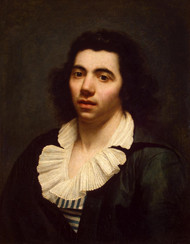Anne Louis Girodet De Roussy Trioson
Published by Therese Myles on 17th Mar 2020
Romanticism was a powerful cultural force throughout the world. In French art, Romanticism reigned supreme for a large portion of the nineteenth century. Anne-Louis Girodet de Roussy-Trioson was one of many artists that helped get it off the ground in the first place. He was born in 1767, and helped set the stage for a lot of what would happen in the next century.
Anne-Louis Girodet de Roussy-Trioson didn't limit himself when it came to choosing artistic subjects. Audiences could see paintings of his portraying Napoleon's victories, along with the mythological themes that were common in the oeuvres of famous artists of the day. However, he was also interested in painting portraits of individuals privately. Political paintings were more characteristic of the Enlightenment, while mythological subjects were more characteristic of the Renaissance and the Romantic period. Portraits, which had practical value, were always in style. In more ways than one, Anne-Louis Girodet de Roussy-Trioson was caught between two worlds, even though he helped create the second.
It would be difficult for an artist during this time period to avoid politics altogether, regardless of his or her particular beliefs or inclinations. Eighteenth century French history is one of the most studied time periods today, and there's a reason for that. The French Revolution changed the course of history, as did the military prowess of Napoleon.
Anne-Louis Girodet de Roussy-Trioson began his art career as a child in 1773, when he first became interested in drawing. His first teacher was Etienne-Louis Boullee, a Neoclassical architect. Jacques-Louis David became Anne-Louis Girodet de Roussy-Trioson's new teacher. Jacques-Louis David was an artist that was very much influenced by the Enlightenment school of thought.
The fact that Romanticism took place almost immediately after the Enlightenment was no coincidence. The Romantics more or less launched a backlash against the rationalism of the Enlightenment. The turmoil of the French Revolution helped motivate some people to move in this direction, and Anne-Louis Girodet de Roussy-Trioson was no exception.
Anne-Louis Girodet de Roussy-Trioson tried to shape many of his later paintings timeless in terms of the emotional responses they created and the ideas they addressed. Anne-Louis Girodet de Roussy-Trioson had personal experience with the way in which a shifting political climate can affect the life of an artist. He was commissioned to do portraits of Napoleon just before Napoleon's reign ended, making his work redundant.
People that were influenced by the Enlightenment school of thought were very much concerned with the present and their place in history and historical developments. The very concept of timelessness was largely removed from the Enlightenment worldview. They focused more on society than the individual. Romanticism became a powerful worldview in its own right, but it began with individuals like Anne-Louis Girodet de Roussy-Trioson experiencing feelings of discontentment in uncertain and unstable times.
The Romantics often celebrated all human emotions, including the dramatic and chaotic ones, which some of Anne-Louis Girodet de Roussy-Trioson's work reflects. Romantics compiled these emotions into the aesthetic concept of the 'sublime.' Anne-Louis Girodet de Roussy-Trioson was interested in capturing this aesthetic and evoking these sorts of emotions. Treating all emotions as an authentic part of one's life experiences as opposed to trying to regulate one's emotions was an important part of the Romantic ideal.
Anne-Louis Girodet de Roussy-Trioson's work was often met with criticism and controversy throughout his life, which is expected for artists that are challenging the establishment of their day in any way. He was fortunate enough to receive a large inheritance relatively late in life in 1815. Anne-Louis Girodet de Roussy-Trioson died in 1824 as a very socially withdrawn man, but his legacy was felt throughout the nineteenth century.

